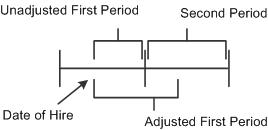Setting Up Elapsed Time Service
To set up elapsed time, use the Service-Elapsed Time (SERVICE_ELAPSED) component.
This topic provides an overview of counting service for multiple jobs and discusses how to set up elapsed time service rules.
|
Page Name |
Definition Name |
Usage |
|---|---|---|
|
PA_SVC_DEFINIT_TM |
Set up basic information about your service definition. |
|
|
PA_SVC_TIME_HRS |
Set up hours thresholds that employees must meet before getting service credit for a computation period. |
|
|
PA_SVC_STATUS |
Establish which employee action and reason codes turn service accrual off and which turn service accrual on. |
|
|
PA_SVC_CAT_SEC |
Set up category-specific rules, including action/reason effective date adjustments, future status code adjustments, and service limits (minimums and maximums). |
|
|
PA_SVC_FINAL_RND |
Set up any adjustments to the total service amount. |
The action and reason dates for adding, adjusting, and rounding are processed before the action and reasons dates are blended. All other calculations are processed after the blending occurs.
Use the Service-Elapsed Time - Definition page page (PA_SVC_DEFINIT_TM) to set up basic information about your service definition. This includes a service period to be used in the elapsed time computation, any periods to exclude from service, and whether contributions are required.
Navigation:
This example illustrates the fields and controls on the Service-Elapsed Time - Definition page.
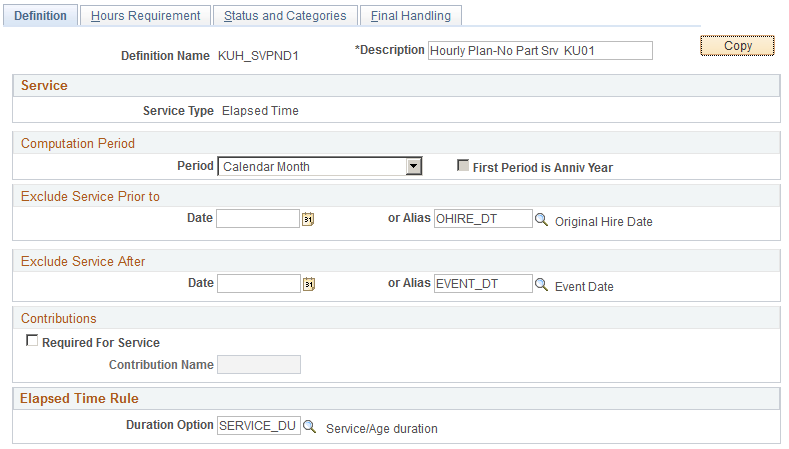
Field or Control |
Description |
|---|---|
Copy |
This is a shortcut you can use to copy a similar definition. Establish the first definition, click the Copy button, enter a new name and description, and the system clones the original definition using the new name. You can then make whatever minor adjustments you need to the new definition. If you have to make major adjustments, consider creating the new definition from scratch instead of copying an existing definition. |
Service
Field or Control |
Description |
|---|---|
Service Type |
When you access this page through the Service-Elapsed Time component, the type is always Elapsed Time. When you access this page through the Service-Hours Counting component, the type is always Hours Counting. When you access this page through the Service-Hours Equivalence component, the type is always Hours Equivalence. |
Computation Period
Field or Control |
Description |
|---|---|
Period |
An elapsed time service definition specifies how to measure the duration between two dates, typically the hire date and the event date. When Pension Administration calculates elapsed time, however, this time is broken into computation periods. Total elapsed time is then the sum of the service credit for each period. Select one of the following period types:
|
Exclude Service Prior to and Exclude Service After
Field or Control |
Description |
|---|---|
Date and Alias |
If you want to exclude service before or after a particular time, such as the participation date, enter a constant date or alias in the Exclude Service Prior to and Exclude Service After group boxes. |
Contributions
Field or Control |
Description |
|---|---|
Required for Service |
Select this check box if employees must contribute to the plan in order to receive service credit. |
Contribution Name |
Enter the name of the employee accounts function result that keeps track of employee contributions. The employee accounts function creates a period-by-period history. If an employee makes contributions at any time during a period, the service function grants the employee service for that period. Note: The best practice is to use an employee accounts period identical to or shorter than the service computation period in order to more accurately align employee contributions to service periods. |
Elapsed Time Rule
Field or Control |
Description |
|---|---|
Duration Option |
Elapsed time methods calculate the difference between two dates. You need to select the date math method for your service calculation result. Enter the name of the method you set up. |
Use the Hours Requirement page (PA_SVC_TIME_HRS) to set up hours thresholds that employees must meet before getting service credit for a computation period. For example, if your computation period is a calendar year, you can require employees to have at least 500 hours of service within a year before getting service credit.
Navigation:
This example illustrates the fields and controls on the Hours Requirement page.
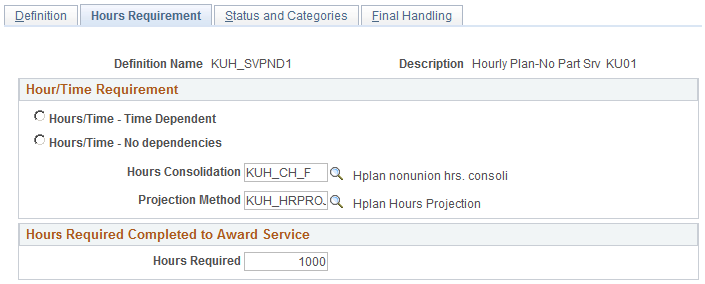
Hour/Time Requirement
Field or Control |
Description |
|---|---|
Hours/Time - Time Dependent and Hours/Time - No dependencies |
Select Hours/Time - Time Dependent if the service requirement depends on the participant meeting an hours threshold. Select Hours/Time - No dependencies it service credit is not dependent on an hours requirement. If you select this option, you can make no further entries on this page. |
Hours Consolidation |
This directs the system to the appropriate hours history for determining whether an employee meets the threshold requirements. |
Projection Method |
This provides instructions for projecting hours, if necessary. |
Hours Required Completed to Award Service
Field or Control |
Description |
|---|---|
Hours Required |
Enter the number of hours that an employee must work before getting service credit. |
Use the Status and Categories page (PA_SVC_STATUS) to establish which employee action and reason codes turn service accrual off and which turn service accrual on.
Note: This page is used when defining elapsed time service, hours counting service, and hours equivalence service.
Navigation:
This example illustrates the fields and controls on the Service-Elapsed Time - Status and Categories page.
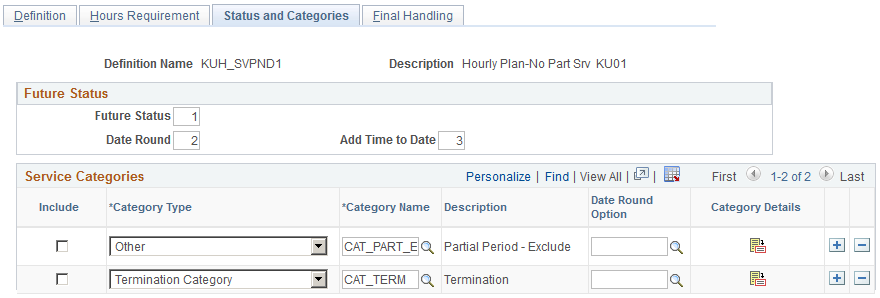
Future Status (Status Adjustment Order)
An employee's HR status determines whether or not the employee accrues service. Status changes are reflected in the employee's action and reason history in the PeopleSoft Human Resources job records: hires, leaves, returns from leave, terminations, and any other action and reason codes you choose.
Sometimes you need to adjust the effective date of a status change. For example, if your plan gives service credit for the first 30 days of a leave, you need to indicate that the effective date of the leave must be adjusted by 30 days before service accrual ends. Further, you can indicate that this adjustment only occurs if the employee returns to work within a year.
Because you can make multiple adjustments to the effective date of a status change, you need to indicate the order in which adjustments are made. For example, you can indicate whether to round a date before or after adding time.
Note: You use the Service Category Detail page to add time to the effective date or to set up adjustments based on future status codes; you enter the rounding method on this page.
Field or Control |
Description |
|---|---|
Future Status, Date Round, and Add Time to Date |
To indicate the order in which the system should apply the adjustments, enter 1, 2, and 3 next to the three adjustment types. Add Time to Date has no effect for hours counting service. Note: If an adjustment causes a date to overlap with the date of another status code, then calculations fail. |
Service Categories
Field or Control |
Description |
|---|---|
Include |
Select this option if actions in the category start an include service segment. If the actions in the category start an exclude service segment, leave that option deselected. Actions not specifically included in any of the categories on this page do not affect service status. Warning! Be sure to include both events that start and stop service. For example, if you stop service for a leave, be sure to start service for a return from leave. |
Category Type |
Set one of the following category types: Hire Category, Termination Category, or Other. The system uses this information when you set up adjustments that add time to a period. You specify whether the adjustments apply to hire periods, termination periods, or all periods. |
Category Name |
In the Service Categories grid, select each HR action and reason category name that the service definition needs to look for. This includes reasons for starting include service segments and for starting exclude service segments. |
Date Round Option |
If you round the effective dates within a category of action and reason events, enter the rounding method next to the category. For example, you might round all hire and rehire dates to the first of the month. |
|
Click the Category Details icon to access the Service Category Detail page, where you set up category-specific rules, including action/reason effective date adjustments, future status code adjustments, and service limits (minimums and maximums). |
Use the Service Category Detail page (PA_SVC_CAT_SEC) to set up category-specific rules in service definitions. These rules can include action/reason effective date adjustments, future status code adjustments, and service limits (minimums and maximums).
Navigation:
Click the Category Details icon on the Status and Categories page.
This example illustrates the fields and controls on the Service Category Detail page.

Add Period Rule
Sometimes you may want to delay the effective date of an action and reason event. For example, if your employee can continue to accrue service for the first month of a leave, you need to adjust the effective date of any leave action by adding a month. Use the Service - Elapsed Time - Add Periods Rules page to add time periods to action and reason effective dates.
Field or Control |
Description |
|---|---|
Record Impacted |
Indicate which instances of a new status receive the adjustment by selecting one of the following: No Records Impacted, All, All But First, All But First and Last, All But Last, First Only, or Last Only, When you add time to an action and reason effective date, you give additional service or break-in-service time by delaying the impact of the change. You may not want to do this for each occurrence of an event. For example, you could grant the 30-day leave of absence adjustment only for the first leave and not adjust any subsequent leaves. If you selectNo Records Impacted, you can make no further entries in this group box. |
Adjustment Rule |
Select Specify Periods to Add to use the fields on this page to define the adjustment rules. Select User Code to perform adjustments using your own custom code. If you selectUser Code, you can make no further entries in this group box. |
Periods to Add, Period Count Alias, and Period Units |
In the Period Units field, select Days, Weeks, Months, or Years. Then enter either a fixed number of days, weeks, months, or years to add, or enter an alias that provides that number. |
Future Status Code Adjustments
The way you treat service for a particular HR status may depend on an employee's subsequent status. For example, employees on leave might accrue service only if they later return to work. You can choose to adjust a current event, based on a future event—or you can adjust a future event, based on a second future event.
Field or Control |
Description |
|---|---|
Adjustment Type |
For each adjustment, select one of the following types:
|
If Action, Reason, Occurs Within, and Does Not Occur Within |
Indicate the action and reason codes of the future event in the If Action and Reason fields. In the Occurs Within fields, enter a numeric value and then select Days, Months, Years, Weeks, or User Code to indicate how far in the future to look for the action and reason codes. Note: If the Adjustment Type is Insert, the condition is that the action/reason does not occur within the given time period. For all other adjustment types, the condition is that the action reason does occur within the given time period. |
Limit
The service function breaks computation periods into segments, based on HR status changes. For example, within a single year-long computation period, an employee might have a ten-month segment of active employment and a two-month segment of leave.
Some HR statuses might have associated minimum or maximum service accruals. For example, employees may be limited to a maximum of one year of service accrual while on leave. You need to set these limits.
Field or Control |
Description |
|---|---|
Limit Type and Service Limit |
In the Limit Type field, Indicate whether there is a limit on the service accrued for an employee who has the include status category by selecting No Limit, Minimum, or Maximum. If you select Minimum or Maximum, enter the minimum or maximum amount of service credit in the Service Limit field. |
Examples of Adjustments
This table provides examples of adding time to the effective date of a status change
|
Actual Action |
Actual Date |
Adjusted Date |
|---|---|---|
|
Hire |
January 1, 1994 |
n/a |
|
Leave |
July 1, 1998 |
August 1, 1998 |
|
Return from leave |
May 1, 1999 |
n/a |
|
Terminate |
December 31, 2000 |
n/a |
This table provides examples of ignoring current status changes
|
Actual History |
Adjusted History |
|---|---|
|
Hire: January 1, 1994 |
Hire: January 1, 1994 |
|
Leave: July 1, 1998 |
n/a |
|
Return from leave: July 15, 1998 |
Return from leave: July 15, 1998 |
|
Terminate: December 31, 2000 |
Terminate: December 31, 2000 |
This table provides examples of ignoring future status changes
|
Actual History |
Adjusted History |
|---|---|
|
Hire: January 1, 1994 |
Hire: January 1, 1994 |
|
Leave: July 1, 1998 |
Leave: July 1, 1998 |
|
Terminate: July 15, 1998 |
n/a |
|
Rehire December 31, 1998 |
Rehire: December 31, 1998 |
This table provides examples of inserting an additional status change
|
Actual History |
Adjusted History |
|---|---|
|
Hire: January 1, 1994 |
Hire: January 1, 1994 |
|
Leave: July 1, 1998 |
Leave: July 1, 1998 |
|
n/a |
Terminate: July 1, 1998 |
Use the Final Handling page (PA_SVC_FINAL_RND) to set up any adjustments to the total service amount. Total service amounts adjustments apply to an employee's lifetime service total, not to the periodic totals generated for each service period.
Navigation:
This example illustrates the fields and controls on the Service-Elapsed Time - Final Handling page.
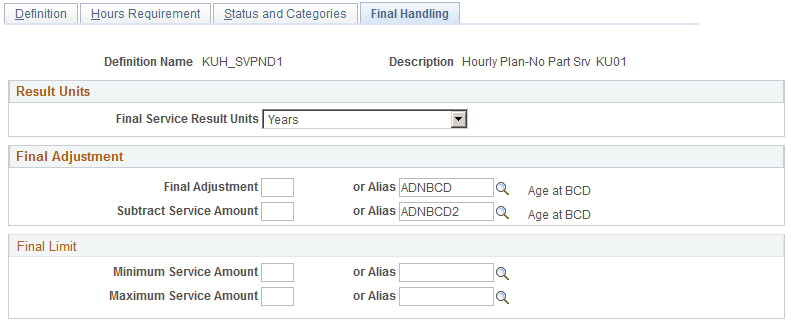
Result Units
Field or Control |
Description |
|---|---|
Final Service Result Units |
Select either Months or Years. |
Final Adjustment
Field or Control |
Description |
|---|---|
Final Adjustment and or Alias |
To add service from an employee's otherwise final service, enter an adjustment amount in the Final Adjustment field. You can add either a constant amount or an alias. |
Subtract Service Amount and or Alias |
To subtract service from an employee's otherwise final service, enter an adjustment amount in the Subtract Service Amount field. You can subtract either a constant amount or an alias. |
Final Limit
Field or Control |
Description |
|---|---|
Minimum Service Amount and Maximum Service Amount |
To limit an employee's otherwise final service to a specified minimum or maximum, enter the limit in the Minimum Service Amount or Maximum Service Amount field. You can enter either constant amounts or aliases. |
